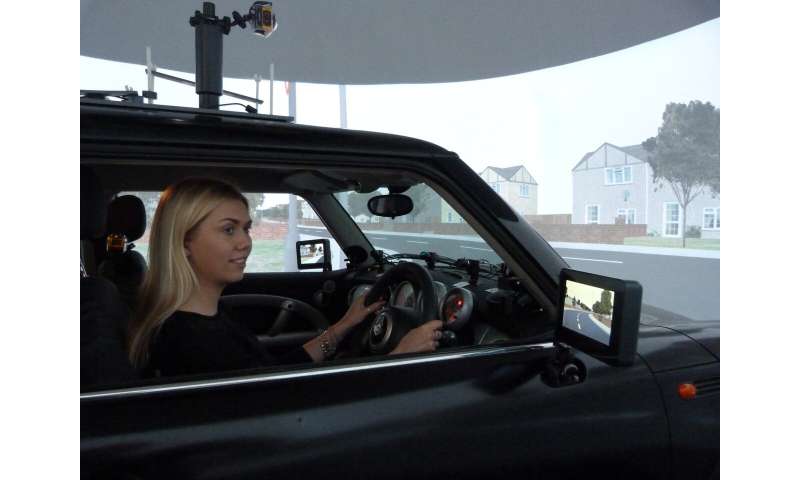Saw but forgot—drivers’ memory lapses puts motorcyclists at risk

There are an estimated 90 fatalities a year in the UK caused by drivers pulling out into the path of an oncoming motorcycle. New research by psychologists at the University of Nottingham suggests this sort of crash may often be the result of a short-term memory failure rather than the driver not seeing an approaching motorcycle.
A series of experiments, carried out in the School of Psychology’s high-fidelity driving simulator, showed that drivers looked at, but seconds later failed to recall, critical approaching vehicles on up to 15% of occasions. Drivers were around 5 times more likely to forget a motorcycle compared with a car.
The research was funded by the ESRC and carried out by Ph.D. student, Chloe Robbins supervised by Dr. Peter Chapman, in the School of Psychology. It suggests that many ‘Look but Fail to See’ (LBFTS) crashes may have been misclassified and are more likely to be a case of ‘Saw but Forgot’ (SBF) errors.
“The ‘Saw But Forgot’ error: A role for short-term memory failures in understanding junction crashes?” has been published in the online journal PLOS ONE and offers practical interventions that may prevent SBF crashes in the future.
Short term memory failure
For each real-world crash there are hundreds of thousands of safe, successful, junction crossings, but when errors do occur they can have fatal consequences. To understand what is going on the research team explored where drivers looked and what they remembered while crossing junctions in a driving simulator. The big surprise from the research was the fact that some drivers have absolutely no recollection of seeing an oncoming vehicle at all even as they are about to pull out at a junction.
Their results suggest that it’s what happens in the moments between seeing an approaching vehicle and pulling out that can lead to a complete absence of memory—particularly for approaching motorcycles.
Dr. Chapman, an expert in the psychology of driving, said: “Typical interpretations of the LBFTS crash are based on the idea that the driver pulling out has failed to devote sufficient attention to the traffic on the road. Our study set out to look for systematic biases in attention towards and memory for different vehicle types. Although these effects were found, the most striking finding was not subtle biases in vision or memory, but the fact that in some cases there was a complete absence of memory, particularly for approaching motorcycles.”
Study 1: Stopping at a junction
The research team recorded the eye movements of 60 drivers crossing junctions in the University of Nottingham’s high fidelity driving simulator—part of NITES (the Nottingham Integrated Transport and Environment Simulation facility). Although drivers seemed to look in the right places as they approached the junction, there were 20 occasions where a driver couldn’t remember one of the oncoming vehicles. The forgotten vehicle was a LGV on 2 occasions, a car on 4 occasions and a motorcycle on 14 occasions.
Study 2: Pulling out of the junction
For this study 30 drivers were required to approach a series of junctions and go straight on, if they thought it was safe to do so. The simulation of oncoming vehicles involved either 2 cars or a car and a motorcycle. The driver’s eye movements were tracked continuously throughout the experiment and memory tests were only given if the driver actually pulled out in front of oncoming vehicles. Out of the 120 times memory was tested drivers failed to report a car on one occasion and a motorcycle on 8 occasions.
Study 3: Tracking head and eye movements
This experiment used the same design as study 2 but now 45 drivers wore lightweight eye-tracking glasses to obtain highly accurate measures of exactly where they looked before pulling out. Out of the 180 memory tests drivers failed to report a car on 3 occasions and a motorcycle on 16 occasions. Of these 16 memory failures there were 5 occasions when the driver had not looked directly at the oncoming motorcycle. These could be examples of typical LBFTS (Look but Fail to See) errors where the driver looked in the right direction but failed to see the motorcycle. In contrast, on the remaining 11 occasions the driver clearly looked directly at the oncoming motorcycle, but couldn’t remember it a few seconds later. The researchers have described these as SBF (Saw but Forgot) errors.
This study also showed that SBF errors were associated with more head movements and a longer gap between fixating on the motorcycle and pulling out. The researchers suggest that this is where the forgetting is occurring. Things the driver looks at between seeing the oncoming vehicle and pulling out might be overwriting the initial contents of visuospatial memory so information about the oncoming vehicle is no longer available at the time a decision is made to pull out.
Dr. Chapman said: “These studies compellingly demonstrate that even in safety-critical situations it is possible to observe dramatic failures of visual memory. These ‘Saw but Forgot’ errors were remarkably frequent in the simulator and we have every reason to think that they may be equally prevalent in the real world. The surprising lack of memory may be exactly why these crashes appear so mysterious.”
The phonological loop – ‘See bike say bike’
As a result of their findings the research team has established a new framework to understand dynamic risky decision-making with an emphasis on the role of short-term memory in such situations. The ‘Perceive Retain Choose’ (PRC) model creates new predictions and proposals for practical interventions.
Specifically, they suggest teaching drivers that if they see a motorcycle approaching, they should say so out loud – ‘See Bike, Say Bike’.
Source: Read Full Article


